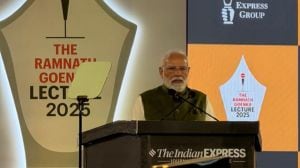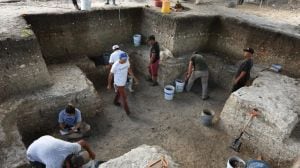THE CONNECTING TRAIN
As work on India’s most challenging railway track—the Jammu-Udhampur-Srinagar-Baramulla link—picks up steam...

As work on India’s most challenging railway track—the Jammu-Udhampur-Srinagar-Baramulla link—picks up steam, photographer Praveen Khanna travels on a train from Jammu to Udhampur, the section that became functional three years ago and brought the region into the national mainstream
YOU don’t have to be an engineer to see why this track is such a marvel. It weaves its way meticulously through the Shivalik range bypassing all barriers, be they mountains or rivers,” says a frequent traveller on the Jammu-Udhampur line. The journey is picture-postcard perfect. Green mountains and steep valleys creep up on you suddenly as the quaint little train chugs along, stopping at stations you never knew existed. Bajalta, Sangar, Manwal and Ram Nagar, tidy little towns nestled among the hilly Shivalik range.
This was the section that first opened three years ago, connecting Delhi and other regions to Udhampur and soon it will extend and travel further into Katra, Qazigund, Srinagar and Baramulla.
With over 36 major and 122 minor bridges on a track that is a little over 53 km long, the one-and-a-half hour journey from Jammu to Udhampur is a delight.
The track runs through almost 10 km of tunnels, the longest of which is 2.45 km. “To put it in perspective, the 2.5-km tunnel is longer than the Jawahar Tunnel on National Highway No. 1 on the Pir Panjal ranges, which connects the Valley to the rest of the country by road,” explains a Northern Railways official.
Digging the tunnels through the mountains was not easy. “It was a real challenge for railway engineers who had never before dealt with the rather strenuous task of laying tracks on a topography that’s so dynamic in nature,” a railway official says.
Perhaps one of the most breathtaking sights on the entire track is the mesmerising view of the Valley as seen from the Gambhir Bridge, which is 77 metre high—higher even than the Qutub Minar.
“I have been travelling daily on this train for almost two years now yet I never tire of seeing the view from up here,” says a passenger. One glance outside and you know what he means. The train seems to be weaving through the clouds.
THE TRACK
The rail line was in the making for two long decades but when the first train finally rolled out of the freshly laid Jammu-Udhampur track, it brought in a new age for an entire generation of Kashmiris. They lined the tracks and cheered as Prime Minister Manmohan Singh “dedicated the rail link to the nation,” on April 13, 2005. Since then, the rail link has become an essential part of the lives of Kashmiri businessmen who finally feel like they are “connected” to the rest of the country. Equally grateful for the rail link, the only one connecting the state to the rest of the nation, are the lakhs of pilgrims who make the arduous journey to Vaishno Devi each year.
“Vaishno Devi is located in Udhampur district in Jammu and before the rail link, the only way to get there was a rather treacherous bus ride from Jammu,” says a Northern Railways official.
Built at a cost of Rs 522 crore, a mere pittance going by the size of the railway kitty today, the project was incessantly delayed due to “lack of funds”.
However, most railway officials concede that even if sufficient funds had been available to them, the incredible geo-technical nature of the sub-mountainous region would have ensured that the rail link took as long as it did to be ready. A technical study on the design features of the track prepared by the then Deputy Chief Engineer (Construction) of Northern Railways, V.K. Duggal categorically stated, “Construction of the Jammu-Udhampur-Baramulla new rail link is the biggest and perhaps the most difficult project undertaken by the Indian Railways in the mountainous terrain since Independence.”
THE PEOPLE
Much like Mumbai’s local rail tracks, the Jammu-Udhampur rail link has given a boost to Jammu’s economy. Businessmen who live in Udhampur use any one of the five trains that ply on this track daily to get to Jammu where they have set shop. “I travelled from Udhampur to Jammu everyday by road before the track was laid but it’s a rather dangerous drive to make and over the past three years I have only be travelling by train,” says Pawan Mehra, a gold merchant who has been shuttling between Jammu and Udhampur daily for the last eleven years. “The track is a lifeline to us businessmen who need to commute daily,” Mehra says.
The track has come as a blessing for students too. “Most of the educational institutes are located in Jammu and before the track was laid, it was difficult for students to commute between Udhampur and Jammu. Now, however, many of us who live in Udhampur, travel to different colleges in Jammu every day,” says Luckey Jamwal, an MBA student at KAWA Institute in Jammu.
So, the daily crowds start flocking at the station early. The first train departs from Udhampur at 6.45 in the morning. They park their motorcycles, and bicycles at the Udhampur station, hop onto the train and set out to seek a living or an education. Some complain that there is no reliable public transport that links the main Udhampur city to the station. “Not all of us have bikes and in the absence of a bus service from the city to the station it sort of dampens the entire purpose of the rail track,” says Sudesh Kumar, an employee at the Government Medical College in Jammu.
Almost 2,000 passengers travel on this line daily. During the pilgrimage season, Northern Railways runs special trains on the route to accommodate the rush of devotees making their way to Vaishno Devi.





- 01
- 02
- 03
- 04
- 05


























